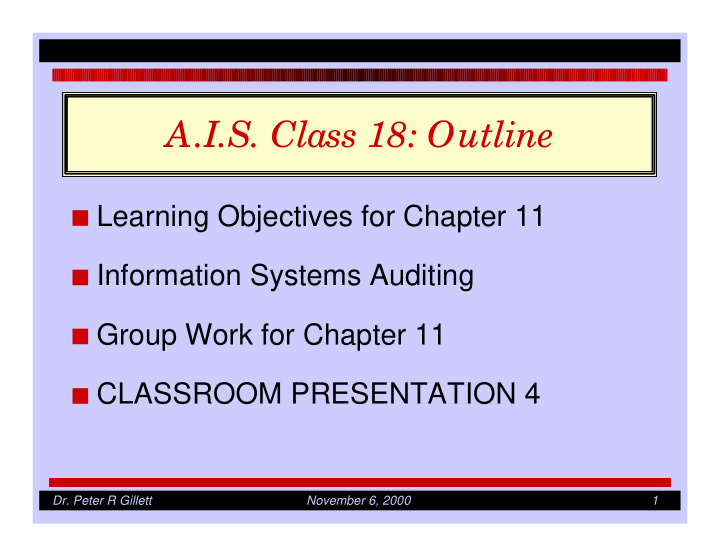



A.I.S. Class 18: Outline I Learning Objectives for Chapter 11 I Information Systems Auditing I Group Work for Chapter 11 I CLASSROOM PRESENTATION 4 Dr. Peter R Gillett November 6, 2000 1
Learning Objectives for Chapter 11 I After studying this chapter you should be able to: N describe the types of audits and auditors N provide an overview of the audit process for financial statement audits N describe the effects of computerization on the accounting process N briefly describe the audit process for financial statement audits Dr. Peter R Gillett November 6, 2000 2
Learning Objectives for Chapter 11 N describe the essence and issues concerning the impact of SAS No. 55 on computer auditing N describe various computer auditing techniques and how they could be applied in database environments N distinguish between auditing around, auditing with and auditing through the computer N explain the process of auditing a relational DBMS N describe the implications of information technology on computer auditing Dr. Peter R Gillett November 6, 2000 3
Information Systems Auditing I Types of Audits F External Audits F Internal Audits N Operation of Internal Controls N Management or Operational F Compliance Audits Dr. Peter R Gillett November 6, 2000 4
Information Systems Auditing I Audit Steps F Establish Audit Objectives F Perform Audit Procedures F Evaluate Audit Evidence F Develop an Audit Opinion F Communicate Audit Results Dr. Peter R Gillett November 6, 2000 5
Information Systems Auditing I Effects of Computerization F Decreased processing visibility F Data only in computer-readable form F Loss of visible audit trail F Extreme consequence of program errors F Lack of common sense F Increase in value of average fraud losses Dr. Peter R Gillett November 6, 2000 6
Information Systems Auditing I Offsetting benefits F Improved prevention F Electronic audit trail F Computer-assisted audit techniques Dr. Peter R Gillett November 6, 2000 7
Information Systems Auditing I SAS 48 F The auditor must assess N the extent of computerization of accounting N the complexity of computer-based systems N the degree to which audit evidence is in computer- readable form only F and identify N computer-based controls Dr. Peter R Gillett November 6, 2000 8
Information Systems Auditing I SAS 55 (& 78) F Internal Control Structure F AR = IR x CR x DR N AR: Audit Risk N IR: Inherent Risk N CR: Control Risk N DR: Detection Risk F Document understanding of internal control structure F Assess control risk (and test controls) Dr. Peter R Gillett November 6, 2000 9
Information Systems Auditing I Audit approaches and Computer Audit F Auditing around the computer F Auditing through the computer N Test data N Integrated Test Facility (ITF) N Embedded Audit Module N Mapping N Source code comparison N Parallel simulation F Auditing with the computer Dr. Peter R Gillett November 6, 2000 10
Information Systems Auditing I Auditing with the computer F Utility programs F DQL (e.g., QBE in ACCESS) F Generalized Audit Software N Data retrieval N Calculations N Edit checks N Reformatting N File operations N Statistics N Reports Dr. Peter R Gillett November 6, 2000 11
Information Systems Auditing I Advanced Technology Environments F Concurrent auditing F Expert systems F Audit program generators F Audit workpapers F PC-based reference software Dr. Peter R Gillett November 6, 2000 12
Group Work for Chapter 11 I Discussion Questions I Problems 6 & 7 Dr. Peter R Gillett November 6, 2000 13
CLASSROOM PRESENTATION I Group Project Stage 4 Dr. Peter R Gillett November 6, 2000 14
Recommend
More recommend